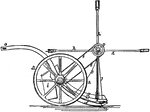Clipart tagged: ‘early pest control’

Adams locust pan
The Adams pan was a simple and effective locust extermination device. A flat pan was filled with coal…

Canfield coal-oil pan
The Canfield pan was a simple and effective locust extermination device. A flat pan was filled with…

Coal-Oil pan
A simple and effective locust extermination device. A flat pan was filled with coal tar and dragged…

KIng Suction Machine
The King Suction Machine was considered one of the most effective locust extermination machines of its…

Peteler locust crushing machine
The Peteler locust crushing machine was a horse drawn device used to trap and kill locusts. Locusts…

Riley Locust-Catcher
One of the best known machines of its type, the Riley Locust-Catcher was employed to exterminate mass…

The Anderson Coal-oil Contrivance.
The Anderson Coal-oil Contrivance was a simple and effective locust extermination device. A flat pan…

The Flory-Locust Machine
The Flory-locust machine was a horse-drawn implement used by farmers to exterminate locust populations.…

The Price Oil-Pan
The Price pan was a simple and effective locust extermination device. A flat pan was filled with coal…

Wilson-Rhode Locust Catcher
The Wilson-Rhode locust catcher was a horse-drawn device used to trap and kill locusts. Locusts were…